engine coolant VOLVO V4 2002 Owners Manual
[x] Cancel search | Manufacturer: VOLVO, Model Year: 2002, Model line: V4, Model: VOLVO V4 2002Pages: 88, PDF Size: 2.34 MB
Page 16 of 88
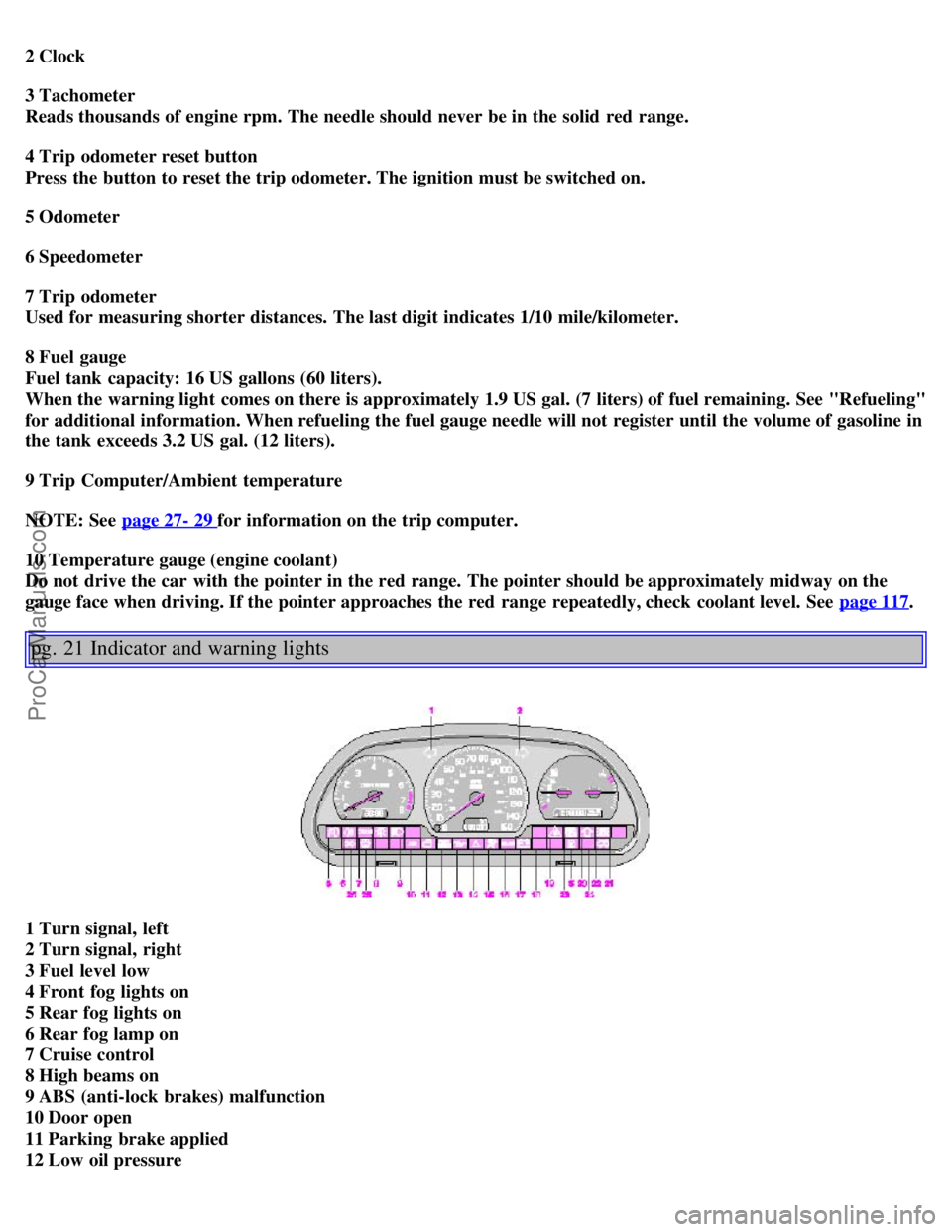
2 Clock
3 Tachometer
Reads thousands of engine rpm. The needle should never be in the solid red range.
4 Trip odometer reset button
Press the button to reset the trip odometer. The ignition must be switched on.
5 Odometer
6 Speedometer
7 Trip odometer
Used for measuring shorter distances. The last digit indicates 1/10 mile/kilometer.
8 Fuel gauge
Fuel tank capacity: 16 US gallons (60 liters).
When the warning light comes on there is approximately 1.9 US gal. (7 liters) of fuel remaining. See "Refueling"
for additional information. When refueling the fuel gauge needle will not register until the volume of gasoline in
the tank exceeds 3.2 US gal. (12 liters).
9 Trip Computer/Ambient temperature
NOTE: See page 27- 29
for information on the trip computer.
10 Temperature gauge (engine coolant)
Do not drive the car with the pointer in the red range. The pointer should be approximately midway on the
gauge face when driving. If the pointer approaches the red range repeatedly, check coolant level. See page 117
.
pg. 21 Indicator and warning lights
1 Turn signal, left
2 Turn signal, right
3 Fuel level low
4 Front fog lights on
5 Rear fog lights on
6 Rear fog lamp on
7 Cruise control
8 High beams on
9 ABS (anti-lock brakes) malfunction
10 Door open
11 Parking brake applied
12 Low oil pressure
ProCarManuals.com
Page 58 of 88
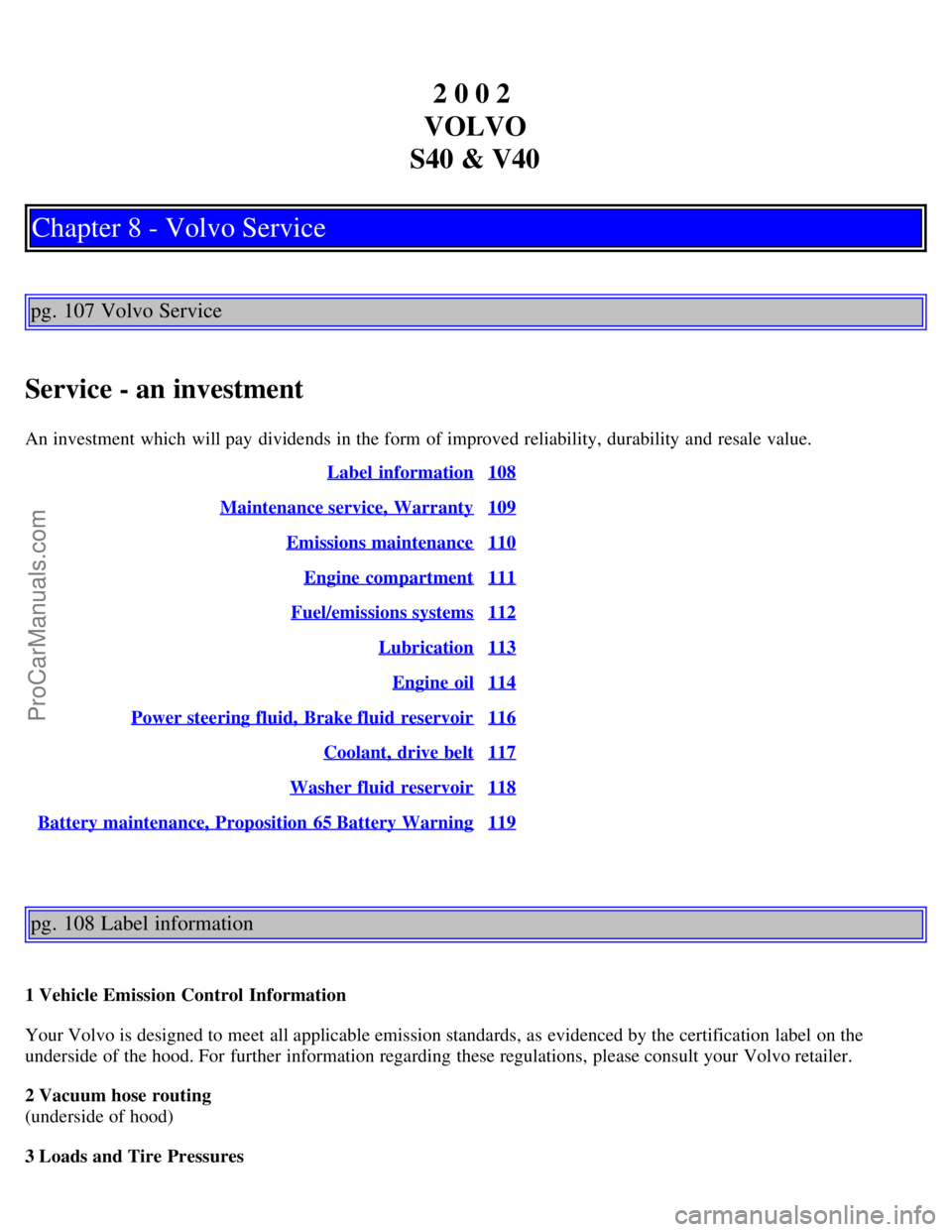
2 0 0 2
VOLVO
S40 & V40
Chapter 8 - Volvo Service
pg. 107 Volvo Service
Service - an investment
An investment which will pay dividends in the form of improved reliability, durability and resale value. Label information
108
Maintenance service, Warranty109
Emissions maintenance110
Engine compartment111
Fuel/emissions systems112
Lubrication113
Engine oil114
Power steering fluid, Brake fluid reservoir116
Coolant, drive belt117
Washer fluid reservoir118
Battery maintenance, Proposition 65 Battery Warning119
pg. 108 Label information
1 Vehicle Emission Control Information
Your Volvo is designed to meet all applicable emission standards, as evidenced by the certification label on the
underside of the hood. For further information regarding these regulations, please consult your Volvo retailer.
2 Vacuum hose routing
(underside of hood)
3 Loads and Tire Pressures
ProCarManuals.com
Page 62 of 88
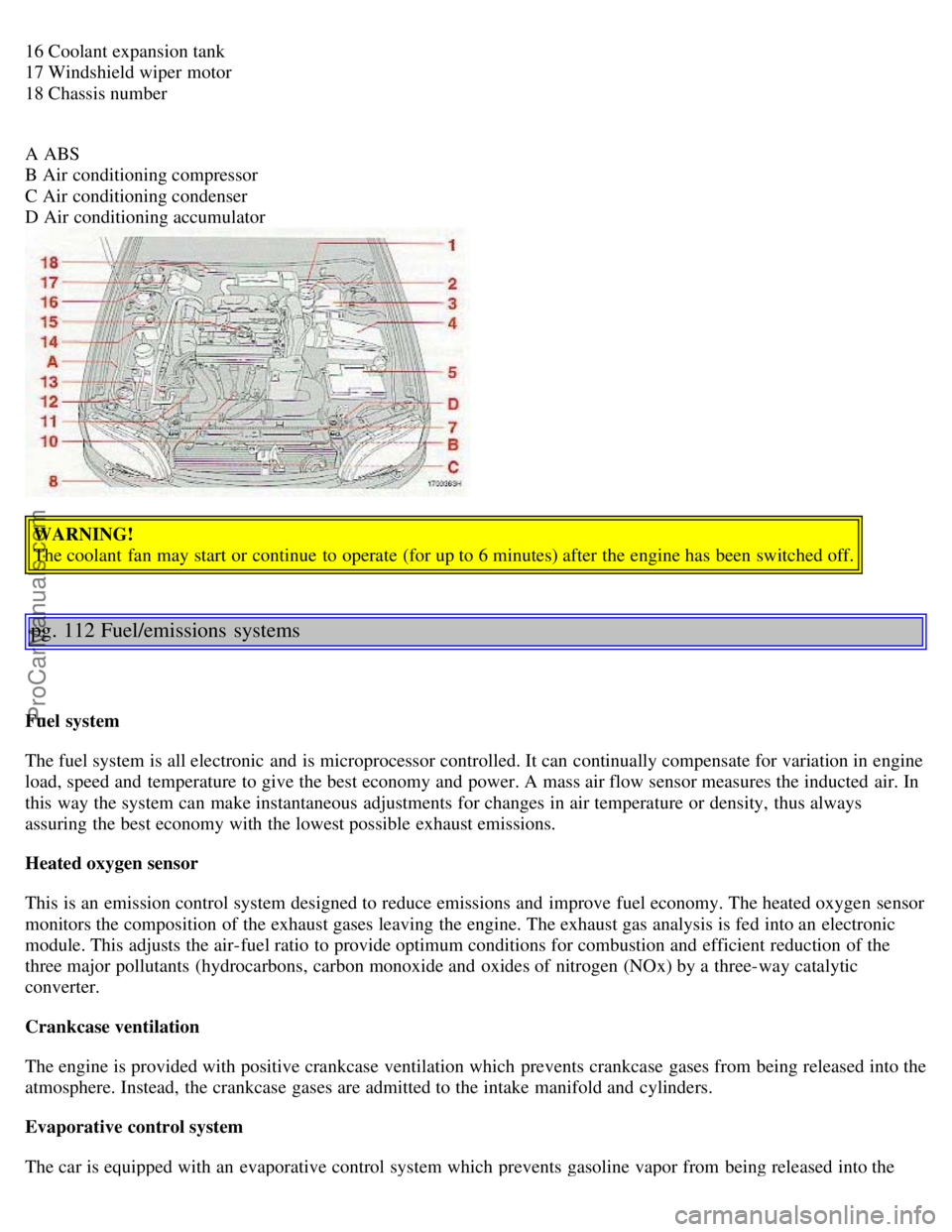
16 Coolant expansion tank
17 Windshield wiper motor
18 Chassis number
A ABS
B Air conditioning compressor
C Air conditioning condenser
D Air conditioning accumulator
WARNING!
The coolant fan may start or continue to operate (for up to 6 minutes) after the engine has been switched off.
pg. 112 Fuel/emissions systems
Fuel system
The fuel system is all electronic and is microprocessor controlled. It can continually compensate for variation in engine
load, speed and temperature to give the best economy and power. A mass air flow sensor measures the inducted air. In
this way the system can make instantaneous adjustments for changes in air temperature or density, thus always
assuring the best economy with the lowest possible exhaust emissions.
Heated oxygen sensor
This is an emission control system designed to reduce emissions and improve fuel economy. The heated oxygen sensor
monitors the composition of the exhaust gases leaving the engine. The exhaust gas analysis is fed into an electronic
module. This adjusts the air-fuel ratio to provide optimum conditions for combustion and efficient reduction of the
three major pollutants (hydrocarbons, carbon monoxide and oxides of nitrogen (NOx) by a three-way catalytic
converter.
Crankcase ventilation
The engine is provided with positive crankcase ventilation which prevents crankcase gases from being released into the
atmosphere. Instead, the crankcase gases are admitted to the intake manifold and cylinders.
Evaporative control system
The car is equipped with an evaporative control system which prevents gasoline vapor from being released into the
ProCarManuals.com
Page 65 of 88
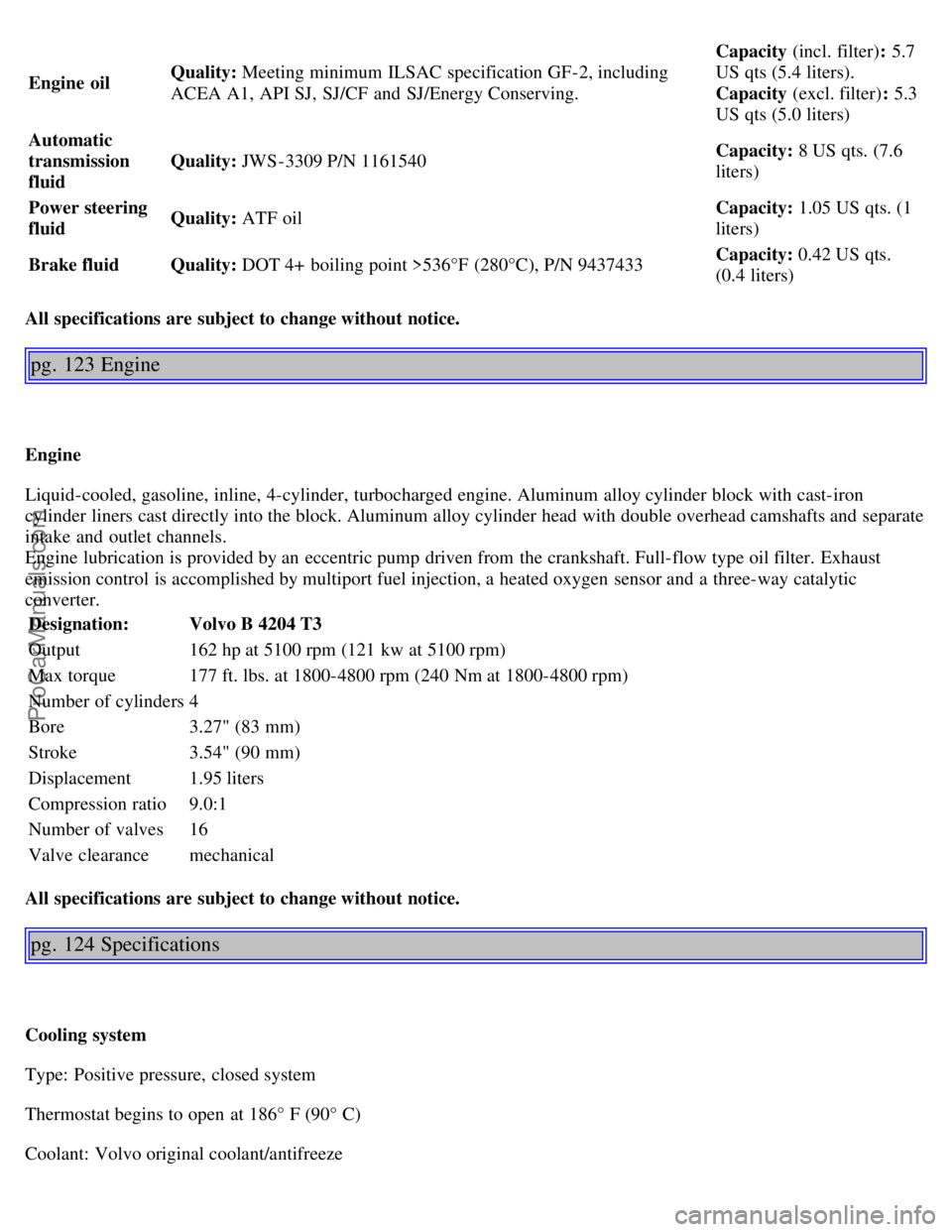
Engine oilQuality:
Meeting minimum ILSAC specification GF-2, including
ACEA A1, API SJ, SJ/CF and SJ/Energy Conserving.
Capacity (incl. filter) : 5.7
US qts (5.4 liters).
Capacity (excl. filter) : 5.3
US qts (5.0 liters)
Automatic
transmission
fluid Quality:
JWS-3309 P/N 1161540 Capacity:
8 US qts. (7.6
liters)
Power steering
fluid Quality:
ATF oil Capacity:
1.05 US qts. (1
liters)
Brake fluid Quality: DOT 4+ boiling point >536°F (280°C), P/N 9437433 Capacity:
0.42 US qts.
(0.4 liters)
All specifications are subject to change without notice.
pg. 123 Engine
Engine
Liquid-cooled, gasoline, inline, 4-cylinder, turbocharged engine. Aluminum alloy cylinder block with cast-iron
cylinder liners cast directly into the block. Aluminum alloy cylinder head with double overhead camshafts and separate
intake and outlet channels.
Engine lubrication is provided by an eccentric pump driven from the crankshaft. Full-flow type oil filter. Exhaust
emission control is accomplished by multiport fuel injection, a heated oxygen sensor and a three-way catalytic
converter. Designation: Volvo B 4204 T3
Output 162 hp at 5100 rpm (121 kw at 5100 rpm)
Max torque 177 ft. lbs. at 1800-4800 rpm (240 Nm at 1800-4800 rpm)
Number of cylinders 4
Bore 3.27" (83 mm)
Stroke 3.54" (90 mm)
Displacement 1.95 liters
Compression ratio 9.0:1
Number of valves 16
Valve clearance mechanical
All specifications are subject to change without notice.
pg. 124 Specifications
Cooling system
Type: Positive pressure, closed system
Thermostat begins to open at 186° F (90° C)
Coolant: Volvo original coolant/antifreeze
ProCarManuals.com
Page 81 of 88
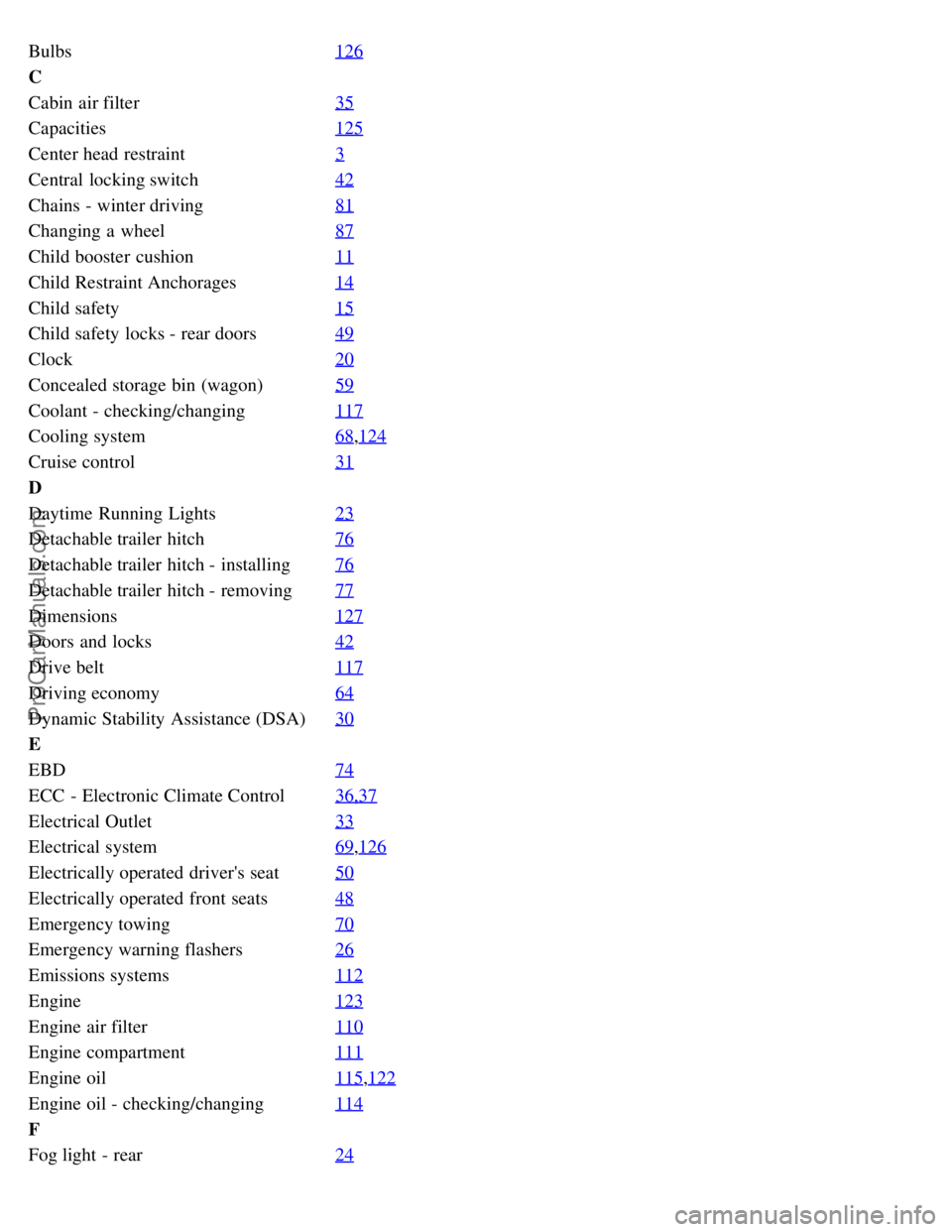
Bulbs126
C
Cabin air filter35
Capacities125
Center head restraint3
Central locking switch42
Chains - winter driving81
Changing a wheel87
Child booster cushion11
Child Restraint Anchorages14
Child safety15
Child safety locks - rear doors49
Clock20
Concealed storage bin (wagon)59
Coolant - checking/changing117
Cooling system68,124
Cruise control31
D
Daytime Running Lights23
Detachable trailer hitch76
Detachable trailer hitch - installing76
Detachable trailer hitch - removing77
Dimensions127
Doors and locks42
Drive belt117
Driving economy64
Dynamic Stability Assistance (DSA)30
E
EBD74
ECC - Electronic Climate Control36,37
Electrical Outlet33
Electrical system69,126
Electrically operated driver's seat50
Electrically operated front seats48
Emergency towing70
Emergency warning flashers26
Emissions systems112
Engine123
Engine air filter110
Engine compartment111
Engine oil115,122
Engine oil - checking/changing114
F
Fog light - rear24
ProCarManuals.com
Page 87 of 88

the vehicle and others sharing the roadway. Avoiding distractions is part of that responsibility.
Octane rating, see page 63
The following should be checked regularly: *
1 Washer fluid reservoir should be filled with water and solvent (wintertime: windshield washer anti-freeze). See
page 118
.
2 Coolant level should be between the expansion tank marks. Mixture: 50% anti-freeze and 50% water. See page 117
.
3 Power steering - When cold, the level must not be above the MAX mark. Top up if necessary with ATF fluid. See
page 116
.
4 Engine oil level should be between the dipstick marks. The distance between the marks represents approx. 2 US qts.
(1.9 liters). See page 114
.
5 Oil filler cap
6 Brake fluid - check, without removing the cap, that the level is above the MIN mark. Use brake fluid DOT 4+. See
page 116
.
* Engine oil should be checked each time the car is refuelled.
Tire pressure, see label located on inside of fuel filler door.
ProCarManuals.com